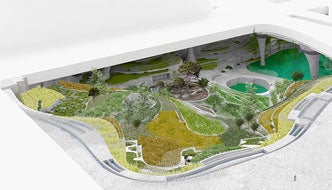
Aerial rendering of a typical “urban swale”, this one located at a road intersection in downtown Los Angeles. Image Credit: Geofutures Post-Professional Program/Rensselaer School of Architecture.
A Rensselaer student project has been selected as the second-place winner in the Dry Futures competition, sponsored by Archinect. The competition was designed to address the unfolding drought crisis in California. Archinect launched the competition last summer—in the fourth year of California’s ongoing drought—asking for bold design proposals that could mitigate the over-consumption of water.
“We believe architects possess a remarkable set of tools and skills that uniquely establish the capacity to adapt to a problem that is both multifaceted and enormous. We are looking for the imaginative, the pragmatic, the idealist, and the dystopian,” Archinect stated.
The competition was divided into two categories: one for speculative projects and the other for pragmatic responses. The “Urban Swales” project received second place in the speculative category. The project was conceived by Muhammad Ahmad Khan, a graduate student in the Geofutures Post-Professional Program in Architecture and Urbanism in the School of Architecture, as part of an advanced design studio conducted by Chris Perry, assistant professor of architecture, head of graduate studies at the School of Architecture, and director of the Geofutures program, and Ted Ngai, a lecturer at the School of Architecture and a studio instructor in the Geofutures program. Additional support was provided by fellow faculty members Fleet Hower, Kelly Winn, and Lydia Xynogala.
According to Khan, “Urban Swales” proposes a series of medium-scale urban excavations throughout the city of Los Angeles, micro-reservoirs that, in addition to collecting periodic storm water runoff for remediation, storage, and redistribution to local communities, provides a new typology of shaded “urban caverns” for human occupation. Additionally, the terraces encourage biodiversity among insects, birds, and small animals, activating the swale as a refuge for wildlife. “As such, Urban Swales not only functions as a distributed form of water management infrastructure, the general ambition of which is intended to relieve the city’s excessive dependence on imported water, but a new form of public space and wildlife refuge as well,” Khan stated.
“The Geofutures advanced design studio for the academic year 2014-15 established coastal flooding and drought as principal architectural problems for consideration by each of the graduate architecture students,” said Perry. “The fall semester began with an introduction to contemporary environmental discourse as it concerns the Anthropocene, an age marked by the existential threat of shifting human-nonhuman relations. As such, the students were challenged to engage the general topic of global warming in practical as well as philosophical terms. If architecture can be understood as a discipline that is both practical and discursive in nature, with buildings considered to be mechanical as well as cultural artifacts, the students were challenged not only to develop new forms of utility in a time of environmental crisis, but new forms of visual and spatial aesthetics as well.

Sectional model of downtown LA “urban swale” showing subterranean reservoir and terraced water filtration landscape as situated below an excavated road intersection. Image Credit: Geofutures Post-Professional Program/Rensselaer School of Architecture.
“The ‘Urban Swales’ project is an exemplar of precisely this twofold ambition,” Perry continued. “The project not only addresses the very real problem of drought in ways that are tangible, but leverages the problem itself as a new opportunity to reimagine architecture and urbanism in a time of global warming. In effect, what was assumed to be only negative is converted into something positive.”
The organizers point out that California only has about one year of water supply left in its reservoirs, and the state’s groundwater, which is supposed to be banked for the future, is being rapidly depleted by industrial farming.
“Urban Swales” is designed to subvert the conventional quest for water as an act of drilling wells into the landscape. Rather than excavating and tapping into existing water reserves or aquifers, it instead activates the potential of dormant urban hydrologies.
According to Perry, the Geofutures graduate program, which offers post-professional master’s degrees in architecture, “endeavors to convert crisis into opportunity by harnessing both the pressures of a planet at risk and the promise of emerging environmental technologies to generate a broad spectrum of possible, if not probable, urban and architectural futures for the 21st century. Premised on the belief that the challenges of the contemporary city are far too complex for any one discipline to manage on its own, Geofutures brings together architects, landscape architects, scientists, and technologists to address a wide range of interdisciplinary issues.”

Sectional axonometric renderings of downtown LA “urban swale” showing different inhabitation zones as the terraced water filtration landscape descends from street level to the depths of the subterranean reservoir. Image Credit: Geofutures Post-Professional Program/Rensselaer School of Architecture
The goal of Archinect is to make architecture more connected and open-minded, and bring together designers from around the world to introduce new ideas from all disciplines. The site has become a top online destination for progressive-design oriented students, architects, educators, and fans.
The Geofutures project is an example of how Rensselaer embodies “The New Polytechnic,” an innovative paradigm for teaching, learning, and research. Recognizing that global challenges and opportunities are so great that they cannot be addressed by the most talented person working alone, nor even by a single discipline, sector, or nation, The New Polytechnic enables collaborations between talented people across disciplines, sectors, and global regions, in order to address the complex problems facing the world. This vision amplifies the ways in which the global impact of Rensselaer research, innovative pedagogy, and transformative student experience are changing the world.


